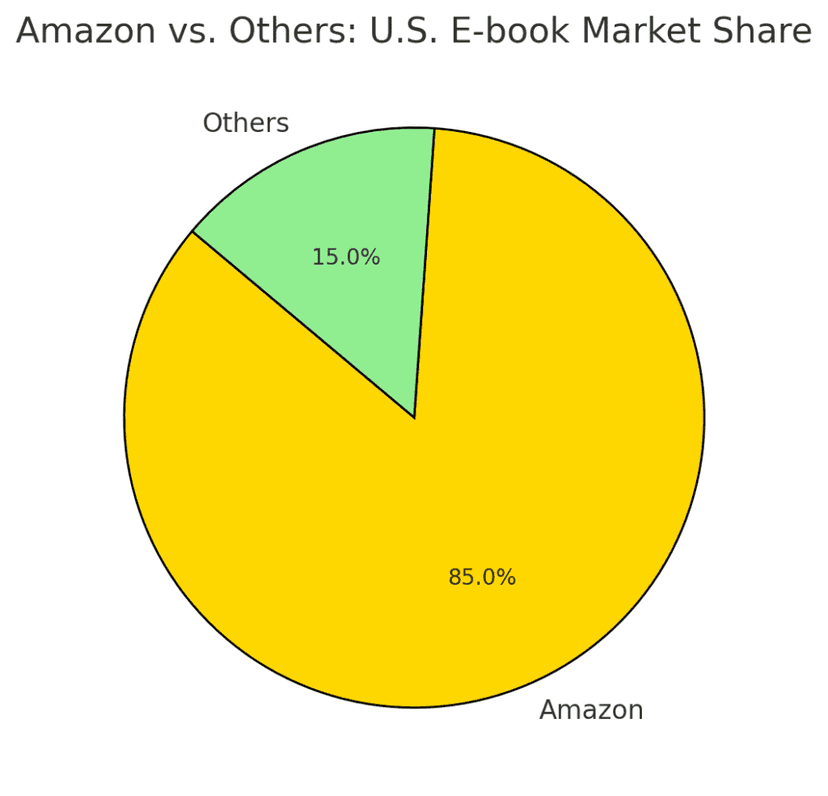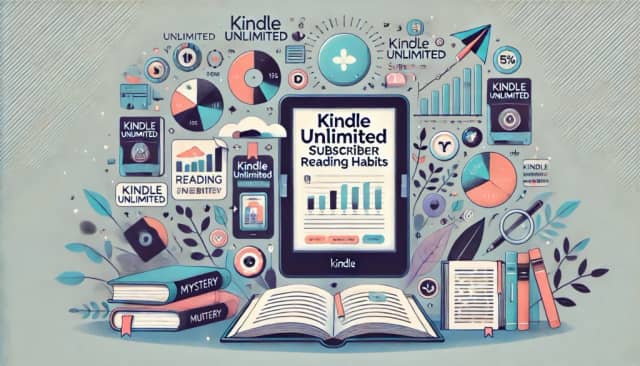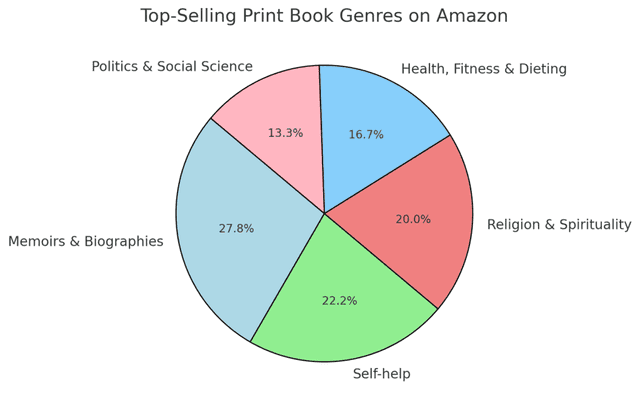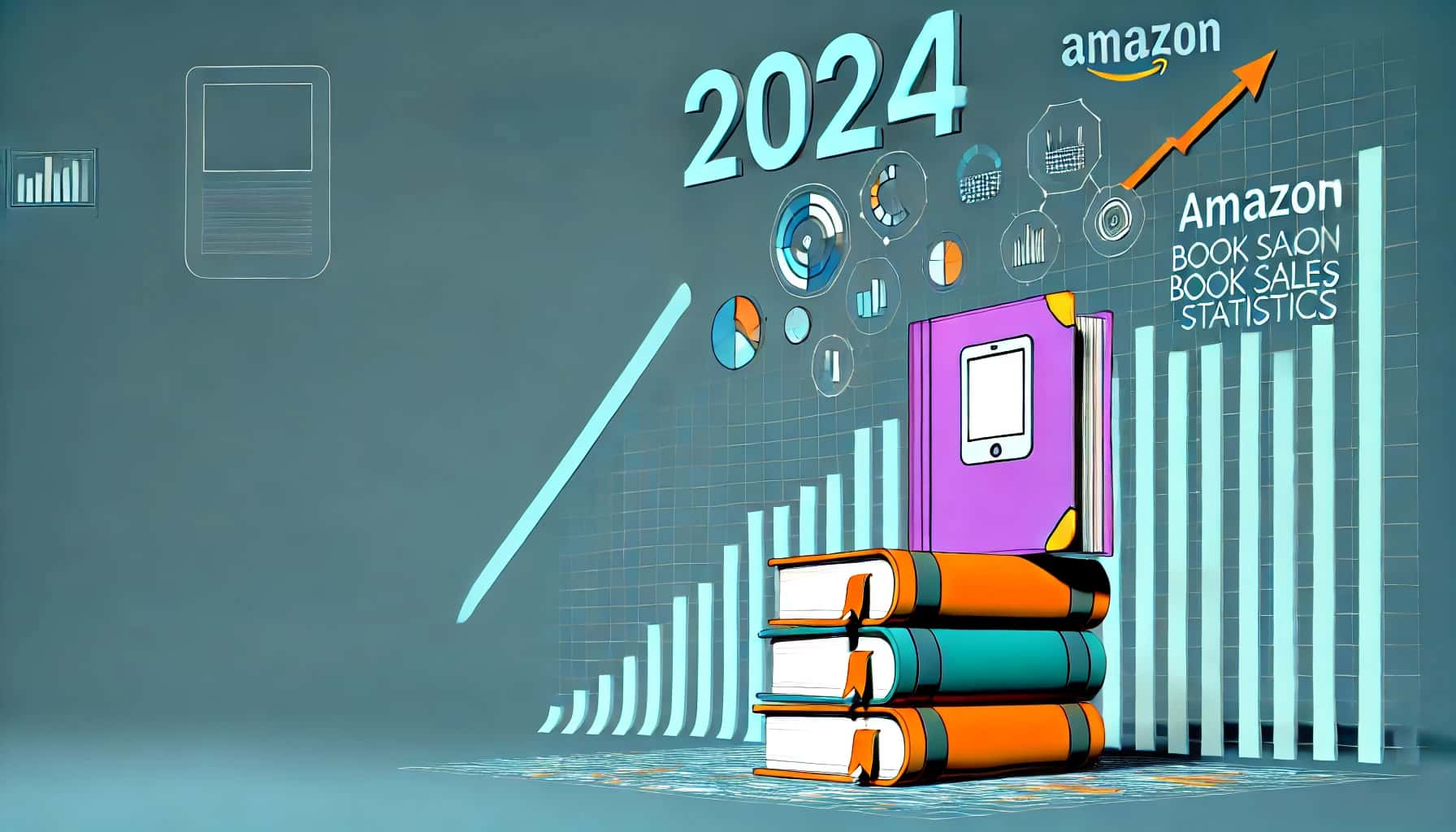Table of Contents
Have you ever wondered just how big Amazon’s influence is in the book world? Well, you’re in the right place. Let’s take a friendly stroll through some fascinating Amazon book sales statistics and see how this retail giant is shaping the global book market and the publishing industry.
We’ll explore everything from e-books and audiobooks to self-publishing, Amazon’s market share, and the ever-growing e-reader market. So grab a cup of coffee (or tea, if you prefer), and let’s dive in!
Amazon’s Dominance in Book Sales
Amazon is still the biggest name in book selling, and the numbers behind it are honestly wild. Whether you prefer e-books, paperbacks, or audiobooks, Amazon continues to shape how the world reads.
Let’s start with the basics.
Massive Catalog:
Amazon now offers more than 44 million book titles around the world. If there’s a book you’re looking for—mainstream, niche, or long out of print—chances are high that it’s available here.
$28 Billion in Book Revenue:
Even in 2025, Amazon continues earning an estimated $28 billion per year from global book sales. That says a lot about how deeply reading habits are tied to this platform.
E-book Market Share Shift:
One of the biggest updates is the U.S. e-book market share. Amazon’s share dropped from 83% to around 67%. It’s still the clear leader, but the shift shows that other platforms like Apple Books and Kobo are slowly gaining ground.
Print Book Powerhouse:
Even with ebook competition, Amazon remains dominant in physical books. It’s responsible for about 50% of all print book sales in the U.S. and sells around 300 million printed books each year.
Still a Top Shopping Category:
Books continue to be one of Amazon’s most-purchased categories, with more than 57 million books sold in recent tracked periods. Reading isn’t going anywhere.

- Sales Rank: Amazon’s sales rank system helps readers discover popular titles, influencing buying decisions and contributing to overall sales figures.
Amazon’s Annual Book Sales Volume
To put things into perspective, here’s a breakdown of Amazon’s annual book sales:
| Format | Number of Books Sold Annually |
|---|---|
| Physical Books | 300 million |
| E-books | Approximately 480–500 million |
| Total | Around 780–800 million |
This table shows the annual sales volume of physical books and e-books sold by Amazon. While the exact e-book number fluctuates, the total remains close to the previously reported 787 million.
Amazon’s Market Share in the U.S. Book Market
| Category | Market Share Percentage |
|---|---|
| All New Book Sales | Over 50% |
| All Book Distribution | About 80% |
| U.S. E-book Market | 67% (down from 83%) |
| Including Self-Published Titles and Kindle Unlimited | Up to ~85% of e-book consumption |
This table outlines Amazon’s dominance in various segments of the U.S. book market. The biggest update here is the decline in the U.S. e-book market share—from 83% previously to about 67% in 2025.
E-books and the E-Reader Market
E-books remain one of Amazon’s strongest categories, even though the overall market has shifted slightly in the past year.
E-book Market Share:
Amazon now holds about 67% of the U.S. e-book market, which is lower than the previously reported 83%, but still far ahead of competitors like Apple Books, Google Play Books, and Kobo. Even with the drop, Kindle is still the go-to platform for most digital readers.
The Kindle Ecosystem:
Amazon’s Kindle lineup continues to dominate the e-reader market thanks to its massive store, easy syncing across devices, and consistent upgrades. Whether you’re on a basic Kindle or a premium Kindle Scribe, the reading experience remains a major part of Amazon’s digital strategy.
Print vs. Digital:
Despite the popularity of e-books, print reading hasn’t gone anywhere. In fact, Amazon still sells about three times more print books than e-books each year. Readers enjoy the convenience of digital, but physical books continue to win in overall volume.
Competitors:
Platforms like Apple Books and Kobo still hold a share of the market, but their numbers remain much lower. Amazon’s reach, catalog size, and self-publishing ecosystem make it incredibly difficult for others to match its scale.
E-books are here to stay, but print continues to dominate purchases—showing that readers love both formats for different reasons.
Print vs. E-book Sales on Amazon
Even with the growth of digital reading, print books continue to dominate Amazon’s overall book sales. Readers still love the feel of a physical book, and the numbers show it clearly.
| Format | Ratio of Sales |
|---|---|
| Print Books | 75% |
| E-books | 25% |
Amazon still sells about three times more print books than e-books, which matches the broader trend across the entire U.S. market. Even though Kindle remains extremely popular, physical books continue to lead in total units sold.
This aligns with 2025 data showing that:
- Amazon handles around 50% of all print book sales in the U.S., and
- Readers still buy print at roughly a 3:1 ratio compared to digital.
Print isn’t going anywhere—if anything, it’s holding its ground even as e-books and audiobooks continue growing.

The Rise of Self-Publishing with Amazon KDP
If you’ve ever dreamed of publishing your own book, Amazon KDP continues to be the easiest and most accessible way to do it. Millions of authors rely on it every year, and 2025 brought some important updates you should know about.
Self-Published Titles Keep Growing:
More than 1.4 million self-published books are released on Amazon annually. That’s an incredible number of new authors entering the market through KDP every single year.
New Royalty Change in 2025:
One of the biggest updates this year is the change to print book royalties.
Starting June 10, 2025, royalties for paperbacks and hardcovers priced below regional price thresholds (such as $9.98 in the U.S.) were reduced from 60% to 50%.
This was one of the most significant KDP changes in years.
Why It Happened:
Amazon also reduced printing costs in 2025, which helps offset the royalty drop a little, but authors publishing lower-priced books will still feel the difference.
E-book Royalties Remain the Same:
Kindle e-book royalties did NOT change. Authors can still earn:
- 70% royalties for most Kindle e-books,
- 35% royalties for other pricing categories or regions.
KDP’s Role in Amazon’s E-book Market:
KDP remains a huge driver of Amazon’s digital book catalog and sales. Self-published books continue to make up a large portion of Kindle’s top-selling titles, especially in popular genres like romance.
Why Authors Love KDP:
- Global distribution
- Fast publishing
- Detailed sales reporting
- Access to Kindle Unlimited
- Ability to update books anytime
- A massive built-in audience
KDP makes publishing accessible to almost anyone, and even with the 2025 royalty changes, it’s still the most popular self-publishing platform in the world.
Amazon Kindle Direct Publishing (KDP) Statistics
| Metric | Value |
|---|---|
| Self-Published Titles Annually | Over 1.4 million |
| Percentage of Amazon E-book Sales | Around 30–31% |
| Royalties Paid to Authors Annually | $300 million to $520 million |
| Authors Earning Less Than $1,000/Year | Approximately 75% |
| Print Royalty Update (2025) | Print royalties reduced from 60% → 50% for books priced below regional thresholds |
This table provides a quick look at Amazon’s self-publishing ecosystem.
The biggest change for 2025 is the updated print royalty rate, which now pays 50% instead of 60% for lower-priced paperbacks and hardcovers.
What is KENP?
You might be wondering, what’s this KENP thing? KENP stands for Kindle Edition Normalized Pages. It’s a standardized way to measure the number of pages read in Kindle Unlimited. Authors earn royalties based on KENP, so the more pages readers flip through, the more the author gets paid. There’s no “ideal” number, but writing engaging content that keeps readers hooked certainly helps!
Kindle Unlimited: A Subscription Game-Changer (UPDATED)
Kindle Unlimited remains one of Amazon’s most popular reading services, and its influence continues to grow in 2025.
Subscription Details:
For a monthly fee of $9.99, readers get unlimited access to over 1.4 million titles. It’s still one of the best deals for heavy readers who love exploring new genres without worrying about individual prices.
How Authors Get Paid:
Authors enrolled in Kindle Unlimited earn money through KENP (Kindle Edition Normalized Pages). The more pages a reader completes, the more the author earns. This system encourages writers to create engaging books that keep readers turning the pages.
Monthly KENP Payout Rate:
The KENP rate continues to update every month. While rates shift slightly, the system still pays out from Amazon’s global KU fund, which distributes millions to indie authors monthly.
Global Growth:
Kindle Unlimited’s availability in regions like Japan (through kdp.amazon.co.jp) shows Amazon’s ongoing push toward expanding its reading ecosystem worldwide.
Audiobook Tie-In:
With audiobooks now making up 15.2% of all adult book sales in the U.S., many KU readers switch between the Kindle version and the Audible narration — a trend that continues to grow with subscription models dominating audiobook consumption.
Kindle Unlimited Subscriber Reading Habits

Kindle Unlimited subscribers remain some of the most active readers on the platform, and 2025 data continues to show strong engagement.
| Metric | Value |
|---|---|
| Average Books Read Per Year | 19 books |
| Total Titles Available | Over 1.4 million |
| Growing Audio Integration | Many KU readers switch between e-book + Audible narration |
Subscribers read far more than casual Amazon customers, and the KU ecosystem continues to grow alongside the rising popularity of audiobooks. With audiobook consumption increasing nearly 24% year-over-year, it’s becoming more common for KU users to blend reading and listening as part of the same title.
This table highlights how engaged Kindle Unlimited readers are, and why KU remains a major driver of Amazon’s overall book consumption.
Consumer Behavior and Trends
Amazon’s influence goes far beyond just selling books. It shapes how readers discover new titles, how much they read, and even which formats they prefer.
Amazon Prime Members Read More:
Prime members continue to buy about 20% more books than non-members. Free shipping, fast delivery, and exclusive offers make it easier for readers to grab new titles on impulse.
Print vs. E-books:
Even in 2025, print still leads the way. Readers continue to purchase physical books at roughly a 3:1 ratio compared to e-books, showing that the tactile experience of reading remains important.
Surging Audiobook Consumption:
This year brought a major shift: audiobooks now represent 15.2% of all adult book sales in the U.S.
With the audiobook market growing nearly 24% year-over-year, formats like Audible have become a core part of many readers’ routines.
Romance Dominates Kindle:
Romance—especially contemporary romance—remains the most competitive and best-selling category on Kindle. Indie authors dominate this space, and many top-performing books come through KDP.
E-books and Audiobooks Together:
The combination of Kindle + Audible continues to reshape reading habits. More people switch between reading and listening, especially through subscription models like Kindle Unlimited and Audible.
Average Revenue Per User:
Because Prime members buy more books and engage more often with Amazon’s digital services, Amazon continues to see higher average revenue per customer compared to non-members.
Amazon’s ecosystem keeps pulling readers in from all angles—print, e-books, audiobooks, and subscriptions—creating a reading environment that’s easy, fast, and hard to leave once you’re in.
Impact of Amazon Prime on Book Purchases
| Customer Type | Average Number of Books Purchased |
|---|---|
| Amazon Prime Members | 20% more than non-members |
| Non-Members | Baseline |
Genre Popularity: What Are People Reading?
Curious about what genres are topping the charts? Let’s take a look.
Top-Selling Print Book Genres
| Rank | Genre |
|---|---|
| 1 | Memoirs and Biographies |
| 2 | Self-help |
| 3 | Religion and Spirituality |
| 4 | Health, Fitness, and Dieting |
| 5 | Politics and Social Science |
Top-Selling E-book Genres
| Rank | Genre |
|---|---|
| 1 | Religion and Spirituality |
| 2 | Memoirs and Biographies |
| 3 | Business and Money |
| 4 | Self-help |
| 5 | Cookbooks, Food, Wine, Spirits |

It’s interesting to see how preferences shift between print books and e-books, isn’t it? Non-fiction seems to dominate, reflecting readers’ desires to learn and grow.
Audiobook Sales Statistics
The audiobook segment is booming, and Amazon’s Audible is at the forefront of this growth.
- Audiobook Sales Statistics: The global audiobook market is growing rapidly, with sales increasing by over 25% annually. Amazon’s Audible holds a significant portion of this market.
- Ebooks and Audiobooks: Combined, ebooks and audiobooks represent a significant shift in how we consume literature, with digital formats becoming more popular compared to traditional print.
- Listening on Devices: More people are listening to audiobooks on their devices, making literature accessible almost everywhere.
- Subscription Services: Services like Audible’s subscription model have changed how we purchase and engage with audiobooks.
Competition and Market Dynamics
While Amazon is a juggernaut, it’s not the only player in town.
- Non-Amazon Sales Channels: Other retailers and non-Amazon sales channels still play a role, though their market share is smaller. Independent bookstores and other online retailers offer alternatives for readers.
- E-reader Market: Competitors like Apple Books and Google Play Books contribute to a diverse e-reader market. They offer unique features and selections that appeal to different audiences.
- Amazon’s Market Strategy: Amazon generates customer loyalty through programs like Prime and Kindle Unlimited, making it tough for competitors to keep up.
- For Example (e.g.): While Amazon dominates, companies like Barnes & Noble and Kobo are trying to carve out their own niches.
Amazon’s Influence on the Publishing Industry
Amazon’s reach extends beyond just selling books.
- Amazon Publishing: With its own publishing arm, Amazon Publishing, the company offers traditional publishing services alongside self-publishing options. It’s a one-stop shop for authors.
- Amazon Releases: They regularly release new tools and programs to support authors, like the recent updates to KDP and international platforms. They’re always innovating.
- Join Our Team: Amazon continually expands, often with job postings inviting people to join our team and contribute to the book industry. It’s not just about books; it’s about building a community.
- Publishing Operations: Amazon’s publishing operations streamline the process for authors and publishers, making it easier to bring books to market.
- Detailed Information: Amazon provides authors and publishers with detailed information on sales, customer engagement, and more, aiding in strategic decisions.
Amazon’s Annual Book Sales ReAmazon’s Annual Book Sales Revenue
Amazon doesn’t release detailed book-only revenue every year, but the latest industry data gives us a reliable estimate of its overall performance.
| Year | Revenue from Book Sales |
|---|---|
| 2021 (last officially reported) | $5.25 billion |
| Estimated Annual Total (2024–2025) | Around $28 billion worldwide |
The latest data confirms that Amazon’s annual book sales revenue remains approximately $28 billion globally, including print books, e-books, and audiobooks combined. This estimate has stayed consistent over the past few years, reflecting Amazon’s stable dominance rather than rapid growth beyond that point.
Amazon continues to hold:
- Over 50% of all new print book sales in the U.S.
- About 67% of the U.S. e-book market
- A fast-growing share of the audiobook segment, which is expanding nearly 24% year-over-year
A significant part of this revenue still comes from Kindle Direct Publishing (KDP) and Audible, both of which continue to play a central role in Amazon’s publishing ecosystem.
Challenges and Considerations
No company is without its challenges, and Amazon is no exception.
- Market Saturation: With so many books available, standing out in the book world can be tough. Authors need to be savvy marketers as well as good writers.
- Royalty Changes: Adjustments in royalty rates can affect authors’ incomes. Staying informed is key.
- Conditions of Use: Understanding Amazon’s policies, like the conditions of use, is essential for authors to avoid pitfalls. Make sure you know your rights and obligations.
- Global Market Dynamics: The e-reader market is growing, but print remains strong in many regions. Balancing formats is important for reaching a wider audience.
Fun Facts and Tidbits
Let’s sprinkle in some interesting nuggets!
- Many Copies Sold: Did you know that the best-selling book on Amazon is “Fifty Shades of Grey” by E.L. James? Love it or hate it, it’s sold millions of copies! Its success highlights how self-published books can become global phenomena through Amazon’s platform.
- 5.00 Rating: Achieving a perfect 5.00 rating on Amazon is a badge of honor for authors. It’s incredibly rare and signifies that every reviewer gave the book a top score. For new authors, even a few high ratings can significantly boost visibility thanks to Amazon’s algorithms.
- Kindle Edition Normalized Pages (KENP): The concept of KENP has changed how authors think about book length and reader engagement. While there’s no ideal number, longer books with compelling content can earn more as readers spend more time immersed in the story.
- Book’s Journey: From the author’s keyboard to the reader’s hands, a book’s journey through Amazon’s system is a marvel of modern logistics. Amazon’s efficient distribution network means that a book can be printed on demand and shipped to your doorstep in just a couple of days.
- E.g., Niche Markets: Niche genres, e.g., specialized non-fiction or unique fiction subgenres, can find an audience thanks to Amazon’s vast reach. Even if a book appeals to a small group, Amazon makes it possible for those readers to find it.
Conclusion
Amazon’s impact on the book industry is immense and multifaceted. From dominating the book-selling market to providing platforms for self-published authors, it’s reshaping how we read, write, and think about books.
While there are challenges and concerns, there’s no denying that Amazon offers opportunities for readers and authors alike. Whether you’re an avid reader, an aspiring author, or just someone curious about the book world, understanding these trends and statistics helps you navigate this ever-evolving landscape.
So, next time you pick up a book from Amazon, you’ll know a bit more about the vast ecosystem behind it. Happy reading! 📖



